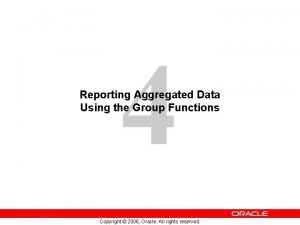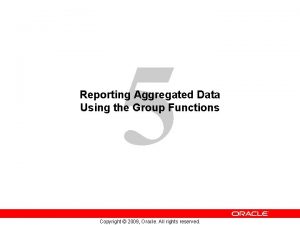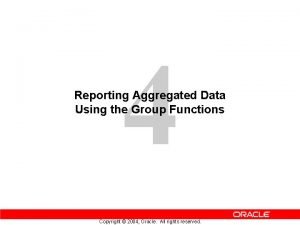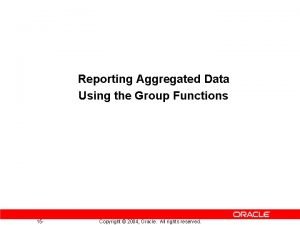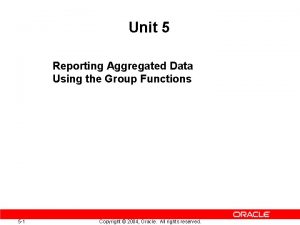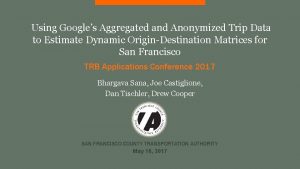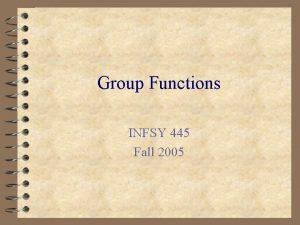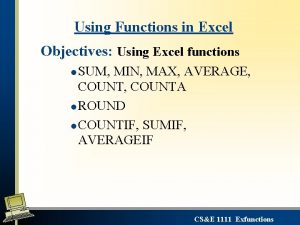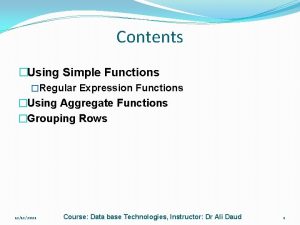4 Reporting Aggregated Data Using the Group Functions




![Group Functions: Syntax SELECT FROM [WHERE [GROUP BY [ORDER BY 4 -5 [column, ] Group Functions: Syntax SELECT FROM [WHERE [GROUP BY [ORDER BY 4 -5 [column, ]](https://slidetodoc.com/presentation_image_h/ea7b1d087a5ff26b719b3debe7d1aa05/image-5.jpg)




















- Slides: 25

4 Reporting Aggregated Data Using the Group Functions Copyright © 2004, Oracle. All rights reserved.

Objectives After completing this lesson, you should be able to do the following: • Identify the available group functions • Describe the use of group functions • Group data by using the GROUP BY clause • 4 -2 Include or exclude grouped rows by using the HAVING clause Copyright © 2004, Oracle. All rights reserved.

What Are Group Functions? Group functions operate on sets of rows to give one result per group. EMPLOYEES Maximum salary in EMPLOYEES table … 4 -3 Copyright © 2004, Oracle. All rights reserved.

Types of Group Functions • • 4 -4 AVG COUNT MAX MIN STDDEV SUM VARIANCE Group functions Copyright © 2004, Oracle. All rights reserved.
![Group Functions Syntax SELECT FROM WHERE GROUP BY ORDER BY 4 5 column Group Functions: Syntax SELECT FROM [WHERE [GROUP BY [ORDER BY 4 -5 [column, ]](https://slidetodoc.com/presentation_image_h/ea7b1d087a5ff26b719b3debe7d1aa05/image-5.jpg)
Group Functions: Syntax SELECT FROM [WHERE [GROUP BY [ORDER BY 4 -5 [column, ] group_function(column), . . . table condition] column]; Copyright © 2004, Oracle. All rights reserved.

Using the AVG and SUM Functions You can use AVG and SUM for numeric data. SELECT AVG(salary), MAX(salary), MIN(salary), SUM(salary) FROM employees WHERE job_id LIKE '%REP%'; 4 -6 Copyright © 2004, Oracle. All rights reserved.

Using the MIN and MAX Functions You can use MIN and MAX for numeric, character, and date data types. SELECT MIN(hire_date), MAX(hire_date) FROM employees; 4 -7 Copyright © 2004, Oracle. All rights reserved.

Using the COUNT Function COUNT(*) returns the number of rows in a table: SELECT COUNT(*) FROM employees WHERE department_id = 50; 1 COUNT(expr) returns the number of rows with nonnull values for the expr: SELECT COUNT(commission_pct) FROM employees WHERE department_id = 80; 2 4 -8 Copyright © 2004, Oracle. All rights reserved.

Using the DISTINCT Keyword • • COUNT(DISTINCT expr) returns the number of distinct non-null values of the expr. To display the number of distinct department values in the EMPLOYEES table: SELECT COUNT(DISTINCT department_id) FROM employees; 4 -9 Copyright © 2004, Oracle. All rights reserved.

Group Functions and Null Values Group functions ignore null values in the column: SELECT AVG(commission_pct) FROM employees; 1 The NVL function forces group functions to include null values: SELECT AVG(NVL(commission_pct, 0)) FROM employees; 2 4 -10 Copyright © 2004, Oracle. All rights reserved.

Creating Groups of Data EMPLOYEES 4400 9500 3500 6400 Average salary in EMPLOYEES table for each department 10033 … 4 -11 Copyright © 2004, Oracle. All rights reserved.

Creating Groups of Data: GROUP BY Clause Syntax SELECT column, group_function(column) FROM table [WHERE condition] [GROUP BY group_by_expression] [ORDER BY column]; You can divide rows in a table into smaller groups by using the GROUP BY clause. 4 -12 Copyright © 2004, Oracle. All rights reserved.

Using the GROUP BY Clause All columns in the SELECT list that are not in group functions must be in the GROUP BY clause. SELECT department_id, AVG(salary) FROM employees GROUP BY department_id ; 4 -13 Copyright © 2004, Oracle. All rights reserved.

Using the GROUP BY Clause The GROUP BY column does not have to be in the SELECT list. SELECT AVG(salary) FROM employees GROUP BY department_id ; 4 -14 Copyright © 2004, Oracle. All rights reserved.

Grouping by More Than One Column EMPLOYEES … 4 -15 Add the salaries in the EMPLOYEES table for each job, grouped by department Copyright © 2004, Oracle. All rights reserved.

Using the GROUP BY Clause on Multiple Columns SELECT department_id dept_id, job_id, SUM(salary) FROM employees GROUP BY department_id, job_id ; 4 -16 Copyright © 2004, Oracle. All rights reserved.

Illegal Queries Using Group Functions Any column or expression in the SELECT list that is not an aggregate function must be in the GROUP BY clause: SELECT department_id, COUNT(last_name) FROM employees; SELECT department_id, COUNT(last_name) * ERROR at line 1: ORA-00937: not a single-group function Column missing in the GROUP BY clause 4 -17 Copyright © 2004, Oracle. All rights reserved.

Illegal Queries Using Group Functions • • • You cannot use the WHERE clause to restrict groups. You use the HAVING clause to restrict groups. You cannot use group functions in the WHERE clause. SELECT FROM WHERE GROUP BY department_id, AVG(salary) employees AVG(salary) > 8000 department_id; WHERE AVG(salary) > 8000 * ERROR at line 3: ORA-00934: group function is not allowed here Cannot use the WHERE clause to restrict groups 4 -18 Copyright © 2004, Oracle. All rights reserved.

Restricting Group Results EMPLOYEES … 4 -19 The maximum salary per department when it is greater than $10, 000 Copyright © 2004, Oracle. All rights reserved.

Restricting Group Results with the HAVING Clause When you use the HAVING clause, the Oracle server restricts groups as follows: 1. Rows are grouped. 2. The group function is applied. 3. Groups matching the HAVING clause are displayed. SELECT FROM [WHERE [GROUP BY [HAVING [ORDER BY 4 -20 column, group_function table condition] group_by_expression] group_condition] column]; Copyright © 2004, Oracle. All rights reserved.

Using the HAVING Clause SELECT FROM GROUP BY HAVING 4 -21 department_id, MAX(salary) employees department_id MAX(salary)>10000 ; Copyright © 2004, Oracle. All rights reserved.

Using the HAVING Clause SELECT FROM WHERE GROUP BY HAVING ORDER BY 4 -22 job_id, SUM(salary) PAYROLL employees job_id NOT LIKE '%REP%' job_id SUM(salary) > 13000 SUM(salary); Copyright © 2004, Oracle. All rights reserved.

Nesting Group Functions Display the maximum average salary: SELECT MAX(AVG(salary)) FROM employees GROUP BY department_id; 4 -23 Copyright © 2004, Oracle. All rights reserved.

Summary In this lesson, you should have learned how to: • Use the group functions COUNT, MAX, MIN, and AVG • Write queries that use the GROUP BY clause • Write queries that use the HAVING clause SELECT FROM [WHERE [GROUP BY [HAVING [ORDER BY 4 -24 column, group_function table condition] group_by_expression] group_condition] column]; Copyright © 2004, Oracle. All rights reserved.

Practice 4: Overview This practice covers the following topics: • Writing queries that use the group functions • Grouping by rows to achieve more than one result • Restricting groups by using the HAVING clause 4 -25 Copyright © 2004, Oracle. All rights reserved.
 Reporting aggregated data using the group functions
Reporting aggregated data using the group functions Reporting aggregated data using the group functions
Reporting aggregated data using the group functions Reporting aggregated data using the group functions
Reporting aggregated data using the group functions Generic components of ooa model
Generic components of ooa model Hình ảnh bộ gõ cơ thể búng tay
Hình ảnh bộ gõ cơ thể búng tay Frameset trong html5
Frameset trong html5 Bổ thể
Bổ thể Tỉ lệ cơ thể trẻ em
Tỉ lệ cơ thể trẻ em Voi kéo gỗ như thế nào
Voi kéo gỗ như thế nào Chụp tư thế worms-breton
Chụp tư thế worms-breton Hát lên người ơi
Hát lên người ơi Môn thể thao bắt đầu bằng chữ f
Môn thể thao bắt đầu bằng chữ f Thế nào là hệ số cao nhất
Thế nào là hệ số cao nhất Các châu lục và đại dương trên thế giới
Các châu lục và đại dương trên thế giới Công của trọng lực
Công của trọng lực Trời xanh đây là của chúng ta thể thơ
Trời xanh đây là của chúng ta thể thơ Cách giải mật thư tọa độ
Cách giải mật thư tọa độ Phép trừ bù
Phép trừ bù độ dài liên kết
độ dài liên kết Các châu lục và đại dương trên thế giới
Các châu lục và đại dương trên thế giới Thơ thất ngôn tứ tuyệt đường luật
Thơ thất ngôn tứ tuyệt đường luật Quá trình desamine hóa có thể tạo ra
Quá trình desamine hóa có thể tạo ra Một số thể thơ truyền thống
Một số thể thơ truyền thống Cái miệng nó xinh thế chỉ nói điều hay thôi
Cái miệng nó xinh thế chỉ nói điều hay thôi Vẽ hình chiếu vuông góc của vật thể sau
Vẽ hình chiếu vuông góc của vật thể sau Nguyên nhân của sự mỏi cơ sinh 8
Nguyên nhân của sự mỏi cơ sinh 8
